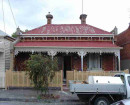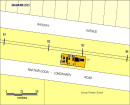Wallan Avenue of Honour
Northern Highway, between Queen and Watson Street,Wallan, MITCHELL SHIRE
-
Add to tour
You must log in to do that.
-
Share
-
Shortlist place
You must log in to do that.
- Download report
Statement of Significance
Both sides of Northern Highway between Queens & Watson Streets
Significant Trees:
Ulmus x hollandica 'Purpurascens' for horticultural value, Historical value: World War 1 x 48
-
-
Wallan Avenue of Honour - Physical Description 1
53 trees planted? 48 surviving? Purple Elm Ulmus x hollandica 'Purpurascens'
Wallan Avenue of Honour - Historical Australian Themes
Remembering the fallen
Wallan Avenue of Honour - Usage/Former Usage
Commemoration
Veterans Description for Public
Wallan Avenue of Honour - Veterans Description for Public
The Wallan Avenue of Honour, planted in the early 1920s, commemorates Wallan's soldiers who served in the First World War. The Avenue includes forty-eight purple leaved Dutch Elms (Ulmus x hollandica 'Purpurascens')and extends along both sides of Northern Highway, between Queens and Watson Streets.The inscription on the sign states; "Memorial Avenue. This stand of elm trees was planted in memory of Wallan residents who served in the Australian Imperial Force in the Great War 1914 - 1918. Lest we Forget." The number of trees that were planted represented the number of Wallan residents who served.
In Australia, commemorative trees have been planted in public spaces since the late nineteenth century. Arbor Days were held regularly in most Victorian State Schools during the late 1800s and early 1900s, and numerous trees were planted in parks in Melbourne and throughout Victoria to mark the visits of important and famous people.
This tradition of commemorative planting was continued in 1901 when at the end of the Boer War trees were often planted for each soldier of the district who was killed in South Africa. These plantings, however, rarely consisted of more than two or three trees in each town.
During and after the First World War avenues of honour consisting of trees lining significant streets became a popular form of commemoration. They represented a new egalitarian approach to the commemoration of soldiers where rank was not a consideration: each tree symbolises a person.
Avenues of honour are a uniquely Australian phenomenon. Australians, and in particular Victorians, embraced the idea of planting them more enthusiastically than any other country in the world. Dating from May 1916, the Eurack Avenue of Honour is the earliest known avenue of honour to be planted in Victoria.
By the time of the Second World War avenues of honour had declined in popularity as a means of commemoration. Today it is estimated that over 300 avenues of honour have been planted in Victoria to commemorate service personnel since 1901.
-
-
-
-
-
Ulmus x hollandica 'Purpurascens
 National Trust
National Trust -
Wallan Mechanics Institute Hall
 Vic. War Heritage Inventory
Vic. War Heritage Inventory -
Wallan Library Honour Roll (First World War)
 Vic. War Heritage Inventory
Vic. War Heritage Inventory
-
10 Down Street
 Yarra City
Yarra City
-
-










